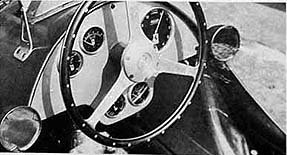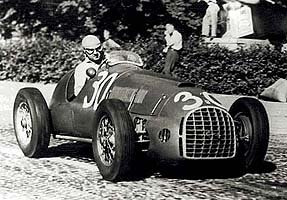Simanaitis Says
On cars, old, new and future; science & technology; vintage airplanes, computer flight simulation of them; Sherlockiana; our English language; travel; and other stuff
THE FIRST FERRARI F1
A CUTAWAY of a car or aircraft can entertain me for hours. This one of the Ferrari 125 is a fine example. There has been a succession of Ferrari Formula One cars over the years, and even a road car named the F1. But 125 F1 was Maranello’s first.

Ferrari 125 F1. Image by G. Cavara, appearing in Vintage Sports Car Number One 2016, journal of the Vintage Sports Car Club of America.
Enzo Ferrari had run the Alfa Romeo racing team during the 1930s. Grand Prix racing resumed slowly after World War II, its cars often having been hidden during the hostilities. In late 1945, Enzo Ferrari gathered several of his former Alfa Romeo colleagues to build and race his own cars.

Aurelio Lampredi at left, and Gioachino Colombo, Ferrari engineers essential to the Scuderia’s success. This and other images from Ferrari Club España.
In 1947, Scuderia Ferrari constructed the Tipo 125, beginning Ferrari’s custom of identifying cars by the displacement of a single cylinder: Its V-12 engine designed by Gioachino Colombo had a total displacement of 1497 cc; each cylinder, 125 cc. This car’s Formula One version arrived in 1948 as the Ferrari 125 F1.
Aurelio Lampredi, another talented Ferrari engine designer, specialized in larger engines: His 3.3-liter, 4.1-liter and 4.5-liter V-12s powered various Ferrari 275, 340 and 375 models, respectively.
The first Formula One regulations followed pre-war voiturette practice with two choices of displacement, 4500 cc for normally aspirated engines, 1500 cc for those that were compressor-fed. (In those days, this meant engine-driven superchargers; Formula One’s exhaust-driven turbos didn’t arrive until the Renault RS01 in 1977.)
Colombo’s Ferrari V-12 was supercharged, initially with a single overhead camshaft actuating two valves per cylinder. Double overhead camshafts came in 1949. A single carburetor was common in those days, Weber being a popular supplier.
The engine’s 6.5:1 compression ratio may sound pitifully low (mundane road cars today are 10:1 and beyond). But gasoline of the era wasn’t particularly high-octane. What’s more, the supercharger’s forced induction raised combustion pressures significantly. The sohc 125 F1 produced perhaps 230 hp at 7000 rpm; dohc and two-stage supercharging later raised this to around 280 at 8000.
The cutaway clearly shows the two-stage supercharger, its casings specially cast to dissipate the heat of compression. It was driven off the front of the engine, the rest of the supercharger nestling in the engine’s vee. The cutaway’s left-hand cylinder bank shows the two camshaft covers of its dohc.
The 125 F1 chassis was fabricated from large-diameter steel tubes, conventional technology for the era. Its front suspension had double-A arms and a transverse leaf spring. The rear axle was located by trailing arms and initially suspended by torsion bars. A transverse leaf spring and a de Dion tube replaced this in a later variant.
To the best of my eye, the cutaway shows the rear leaf spring, its left extremity ghosted through the brake drum. Also, at front and rear, note the heat-dissipating ventilation of the era’s drum brakes. (Though the diminutive Crosley had “spot” brakes, i.e., caliper discs, as early as 1949, brakes of this type didn’t appear in international racing until the 1952 Jaguar C-type sports car. Disc brakes are ubiquitous today on cars of all sorts.)
The era’s shock absorbers were of the lever-action variety, as opposed to today’s conventional tubular shocks. The cutaway shows this traditional damping; look for squat cylinders with lever arms linked to the wheel hubs. Maurice Houdaille developed this damper design in 1906; Ferrari didn’t forsake Houdailles until the late 1950s. (My 1958 Ford Consul also had lever-arm shocks, albeit not Houdailles, at the rear.)

At left, the Houdaille damper of 125 F1 front suspension; at right, rear suspension’s Houdaille and a peek at the transverse leaf spring.
Other traditional elements visible in the cutaway include the F1’s wire wheels with knock-off hubs. Instead of pneumatic tools and 3-second tire changes, pit stops of the era involved brass hammers wielded to unscrew the knock-offs, with rather less than today’s orchestration.
It goes almost without saying that drivers used a gear lever to up- or downshift; in the Ferrari F1’s case, to the driver’s left in the cockpit. Also, the Ferrari wood-rim steering wheel was itself a work of art, blissfully free of buttons for communications, Drag Reduction System, operational optimization and who knows what. Plus, race spectators saw considerably more of drivers than simply their helmet graphics.
The Ferrari 125 F1’s first race was on September 5, 1948, at the Valentino Grand Prix. I could uncover no more information of this race or circuit, even in G.N. Georgano’s typically encyclopedic volume, aptly named The Encyclopedia of Motor Sport, 1971. The three cars entered were driven by Guiseppe Farina (destined to take the inaugural World Drivers’ Championship in 1950), Frenchman Raymond Sommer and B. Bira (Thai prince and a grandson of King Mongkut of The King and I fame.)
The 125 F1’s first victory came less than two months later, on October 24, 1948, at the Garda Circuit around Lago di Garda, with Farina at the wheel. The next year, 125 F1s took five wins, including the Italian Grand Prix at Monza, the Zandvoort Grand Prix in The Netherlands and the Grand Prix of Switzerland (back before the Swiss outlawed motor racing of all sorts in reaction to the 1955 Le Mans disaster.)
Ferraris took six more victories in 1950 and 1951. Already in the planning was a 1954 change of regulation to 2.5-liter normally aspirated engines. For 1952 and 1953, World Championship Grands Prix followed the Formula Two limits of naturally aspirated 2.0-liter power (or, rarely attempted, a supercharged 750-cc option).
There was nothing as useless as an out-dated race car, so 125 F1 chassis were all used elsewhere or lost. However, a replica with an original Colombo engine resides in Modena’s Museo Enzo Ferrari.

The car in the foreground of these Ferrari Formula One cars is a reconstructed 125 F1. Image by Gregorburns.
There are other Ferrari 125 F1 cutaways to be enjoyed at favcars.com and favcars.com/wallpaper. Also, there’s a 125 F1 video game that looks quite real, but for a few giveaways. ds
© Dennis Simanaitis, SimanaitisSays.com, 2016





Very interesting and informative article, Dennis (as usual). Here are the results of the 1948 Italian GP at the Valentino Park circuit and some track details:
https://en.wikipedia.org/wiki/1948_Italian_Grand_Prix
Also, a relevant page from Anthony Pritchard’s book, ‘Grand Prix Ferrari’, with a race recap of the 1948 Italian GP documenting how Enzo’s new monoposto 125s fared in the event:
https://books.google.com/books?id=Z8fBCQAAQBAJ&pg=PA14&lpg=PA14&dq=1948+valentino+grand+prix&source=bl&ots=rqHB0A_k-4&sig=YR4IqK6_JYFATZ0r-jss1EWcFrg&hl=en&sa=X&ved=0ahUKEwjh5MGMnNfLAhWnvoMKHYZIBtoQ6AEILTAD#v=onepage&q=1948%20valentino%20grand%20prix&f=false
Correct me if I am wrong, but gasoline was only used in Grands Prix after the 2.5 Liter naturally aspirated cars of 1954. Methanol was the essence during the high horsepower 750 Kilogram era before the Hitler War and its better latent heat of vaporization allowed for high boost and reasonable compression ratio simultaneously?